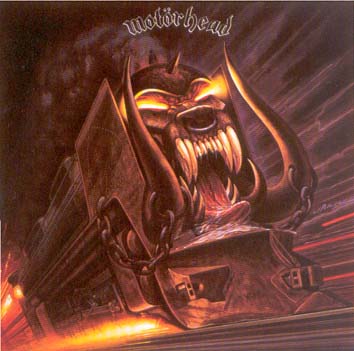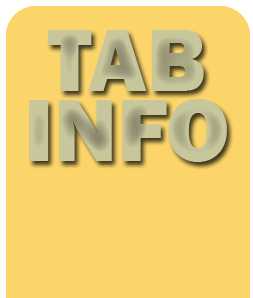
Motörhead
" Built for speed "
album: Orgasmatronjaar/year: 1986 gitaar/guitar: Phil Campbell & "Wurzel" Burston
compositie/composition: Kilmister/Burston/Campbell/Gillstem stem alle snaren een halve noot lager
tune down all strings a half step enkele "tussenriffs" zijn bij deze tab niet uitgezocht
some "in between riffs" aren't shift out in this tab
7p5 = pull-off
12(p0) = lichte pull-off die ontstaat zonder de snaar daadwerkelijk weg te slaan/
slight pull-off, which arises without actual knocking off the string
7tr9 = snel herhaalde pull-off + hammer-on (=trill)/
rapidly repeated pull-off + hammer-on (=trill)
t5 = tab
8b9 = druk 8e fret op naar 9e/bend 8th fret to 9th
b9 = sla opgeduwde toon aan /strike bended tone
7b8r7 = druk 7e fret op naar 8e en laat weer terugkomen in oude positie/
bend 7th fret to 8th and release to old position
7b = druk de snaar een klein beetje op/bend the string a little bit
~ = vibrato/vibration
~~ = veel vibrato/much vibration
\ = slide omlaag/slide down
/ = slide omhoog/slide up
\\\ = langzame slide omlaag/slow slide down
/// = langzame slide omhoog/slow slide up
> = strijk plectrum over snaren omhoog/bow up pick across strings
x = percussieslag/percussionstrike
0 = afdempen/mute strings
0 = licht afdempen/mute strings slightly
10.10 = speel zeer snel achter elkaar/play very fast behind each other
(2) = wordt af en toe gespeeld/ is played sometimes
<7> = kunstmatige flagolet/artificial harmonic
^7^ = natuurlijke flagolet/natural harmonic
>7 = accent geven/give accent
v = neerslag/downstroke
^ = opslag/upstroke
* = onduidelijk/unclear
( = als arpeggio aangeslagen/striked as arpeggio
R = rust/rest
H = toon aanhouden/hold tone
 Deze tab kun je gewoon printen met Ctrl + P (Windows) of Apple + P (Apple) - "selectie" NIET aanvinken/
Deze tab kun je gewoon printen met Ctrl + P (Windows) of Apple + P (Apple) - "selectie" NIET aanvinken/You can print this tab just easily with Ctrl + P (Windows) or Apple + P (Apple) - do NOT mark "selection"
RIFF A COUPLET/VERSE
iedere eerste keer/every first time
E -------------|---------------------------------------------------------|
B -------------|---------------------------------------------------------|
G -------------|------------------------------------------------0--------|
D -------------|-----9-----9-----7-----9-------------9-----9--R-5--------|
A ->5-->4-->2--|-H---7-----7-----5-----7-------5~----7-----7--R-3--------|
E ->3-->2-->0--|-H-----0-0---0-0---0-0-----5-7-----0---0-0---------------|
daarna/afterwards
E ---------------------------------------------------------|
B ---------------------------------------------------------|
G -----------------------------------------------(0)-------|
D -----9-----9-----7-----9-------------9-----9--R-5--------|
A -----7-----7-----5-----7-------5~----7-----7--R-3--------|
E -0-0---0-0---0-0---0-0-----5-7-----0---0-0-----(3)-------|
RIFF B REFREIN/CHORUS
E ---------------------------|---------------------------|
B -3-3----------5-5----------|-3-3-----------------------|
G -4-4----------4-4----------|-4-4----------2-2----------|
D -4-4----------4-4----------|-4-4----------2-2----------|
A ---------------------------|--------------0-0----------|
E ---------------------------|---------------------------|
afronding/rounding:
E ---------------------------|----------------------------|
B -3-3----------5-5----------|-3-3----------------drum----|
G -4-4----------4-4----------|-4-4---------------roffels/-|
D -4-4----------4-4----------|-4-4-------->2------fills---|
A ---------------------------|------------>0---5----------|
E ---------------------------|-----------------3----------|
SOLO 1
andere gitaar speelt/other guitar plays: F#5 - A5 - F#5 - A5
RIFF B variatie/variation
later in song met
effecten en variaties/
lateron
in song with effects and variations
SOLO 2
over riff B
RIFF C
accoustisch door 2e
gitaar; met vele variaties/
clean tone by 2nd guitar; with many variations
(gitaar 1 speelt riff A/guitar 1 plays riff A)
-1.-7. keer/time--8. keer/time
E --------------|------------------|
B ---------8-8--|------------------|
G -x-x-x-x-7-7--|-9b~---7-7-9-7~---|
D -x-x-x-x-5-5--|-7b~---5-5-7-5~---|
A --------------|------------------|
E --------------|------------------|
EINDE VAN SONG/END OF SONG
E --------------------------------------------------------------------|
B --------------------------------------------------------------------|
G --------------------------------------------------------------------|
D ->7---->5------->7---->5------->7---->5------->7---->5------->7-----|
A ->5---->3------->5---->3------->5---->3------->5---->3------->5-----|
E --------------------------------------------------------------------|
rode
tablature: sla vaak snel achter elkaar aan/
red tabs: strike fast a greater times after eachother
E -------------------------------------------------------------|
B -------------------------------------------------------------|
G -------------------------------------------------------------|
D -4----------------------2----------------2-------------------|
A -2----------------------0----------------0----->5-->4-->2--R-|
E ----------------------------------------------->3-->2-->0--R-|
Ik heb hier veel werk ingestoken, dus waag het niet zonder mijn toestemming (behalve voor eigen gebruik) het te kopieëren $#!@>!! •
• This tab is my own interpretation of this song.
I've put a lot work to it, so don't you dare copy it (except for own use) without my permission $#!@>!! •
© 2000 - 2026 Michiel Hautus • website: www.rockarolla.nl

